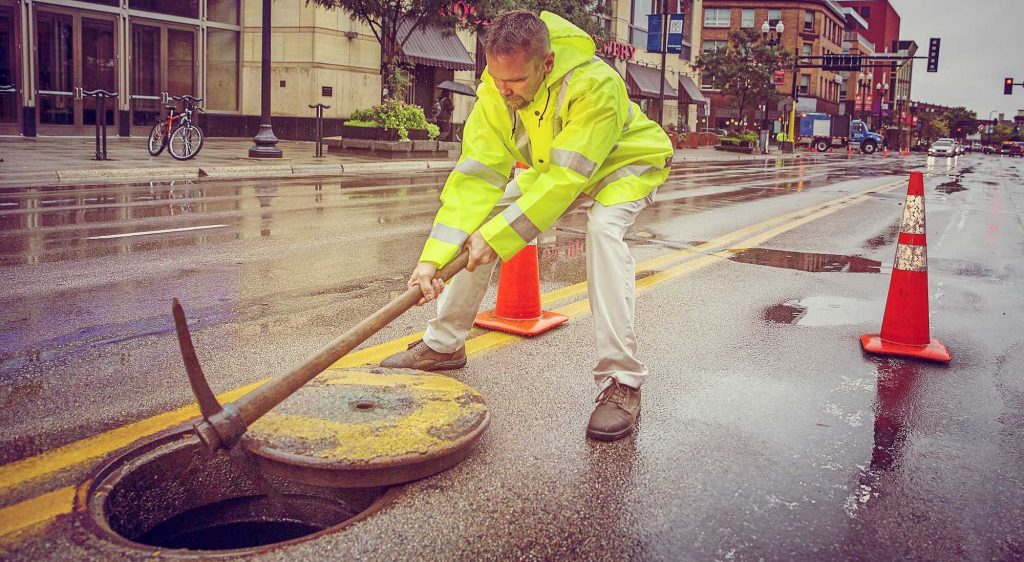New Grease Trap Cleaning Rules Ensure Minnesota Restaurants Keep Grease Out Of Sewers
Grease washed from restaurant frying pans and dirty dishes is creating a fatty mess in Minnesota sewers and public works crews hope new rules will unclog the subterranean arteries.
Cities across the state have been getting more aggressive in recent years about diverting fats, oils and greases from the sewers — where it is costly to remove and causes dangerous backups. Minneapolis is now preparing its own ordinance requiring restaurants to collect their fat before it leaves the premises.
“Over time fat builds up in the pipe and restricts the flow,” said Katrina Kessler, the city’s director of surface water and sewers. “In a dire situation, the sewage can back up into the basements of buildings, homes, or sometimes up in a manhole onto the street.”
Rochester, Roseville, Elk River, Bloomington, Golden Valley and Duluth have created their own fats, oils and grease (FOG for short) programs in recent years. And staff in St. Louis Park and West St. Paul say they are also discussing it.
Restaurants typically collect and recycle their fryer oil. But the plumbing code usually requires them to have a settling tank, known as a grease trap, that allows fats to float out of water that has washed down the drain. Some cities are now making sure restaurants are using and properly maintaining their grease traps, which must be cleaned regularly.
Louis Barron, owner of TLK Sewer and Drain Cleaning, sometimes gets calls from restaurants that haven’t had grease trap cleaning in months or years. He then has to use a trowel to scoop out a stinky block of grease.
“It’s a mess,” Barron said. “Believe me, when I see that, I give them what-for.”
Some jobs smell so bad that restaurant employees flee the scene for clean air. “I don’t smell it anymore,” Barron said. “I’m nose blind.”
Public works departments are increasingly sending camera-equipped rovers into pipes to check their condition, which may have helped raise awareness of the fatty buildups. Video from Minneapolis shows pipes lined on their sides with the craggy light brown material, which occasionally plops into the murky water as a water jet passes by. Massive buildups, such as those that recently afflicted London, are called “fatbergs.”
Kessler estimates the city has spent $1 million cleaning fat in the past five years, returning every other week to blast the city’s 35 hot spots with high-pressure hoses. Minneapolis crews regularly have to clean out a pipe at 9th Street and Hennepin Avenue, for example.
“That’s fairly ripe. That’s a lot of grease,” sewer maintenance supervisor Sean Oberg said of the foul smell that emerged while watching the hose do its work through a manhole one recent morning. “The sanitary tunnels aren’t even that bad.”
In St. Louis Park, a fat blockage in the West End area last December sent raw sewage up the floor drains of several restaurants and other businesses.
“It’s definitely been more on the radar these days, especially with a lot of the camera televising that we’re doing,” said Jay Hall, the city’s utilities superintendent. The city expects to bring a proposal to tackle the issue to the City Council.
Rochester started a program in 2017 and discovered 27 restaurants didn’t have anything stopping grease from going down the drain.
“There’s been quite a few restaurants where we call to set up the inspection, and they don’t know what the grease trap is,” said Chelsea Wiegand, an environmental specialist for the city. “And then there’s a few where we schedule the inspection and then when we get there we end up having to help them look for it.”
People who run public utilities are all too familiar with the problem, however. “You go to the conferences, and you read the magazines, they’re talking a lot about fats, oils and greases and how to manage them,” said David Lane, environmental manager at Rochester’s water reclamation plant.
So where is all the grease supposed to go? If it originates in the Twin Cities, it likely heads to the Metropolitan Council’s massive wastewater plant in St. Paul. The Metro Plant took about 1.7 million gallons of grease trap waste last year from the three haulers who exclusively dump that material, according to the Met Council. What’s left after treatment ends up in landfills.
Minneapolis stresses that its program will be focused on educating, not punishing, restaurants. The proposed ordinance does allow staff to fine or cut off water from restaurants that don’t comply after repeated warnings.
“Education and outreach is the first component and the longest component. And that’s just ongoing,” Kessler said.
The city’s code does not explicitly prohibit dumping grease into the sewers. It does bar butchers from flushing internal organs from meat preparation. The proposed change would replace some of the antiquated sections with updated language, which addresses grease and also requires restaurants to maintain their grease traps.
“It seems like a no-brainer to me, that it would be something that restaurants would also want to do,” said Jodi Ayres, chef at the Lowbrow in south Minneapolis. The restaurant regularly has its chest freezer-sized grease trap cleaned.
“Because it’s going to protect your plumbing in the long run,” Ayres added. “If you’re a restaurant, you should care about your plumbing.”
To prevent food solids from clogging your grease trap and causing problems in the sewer system, consider installing The Drain Strainer. Invented by a former restaurant owner, The Drain Strainer is an effective and affordable commercial garbage disposal alternative.

